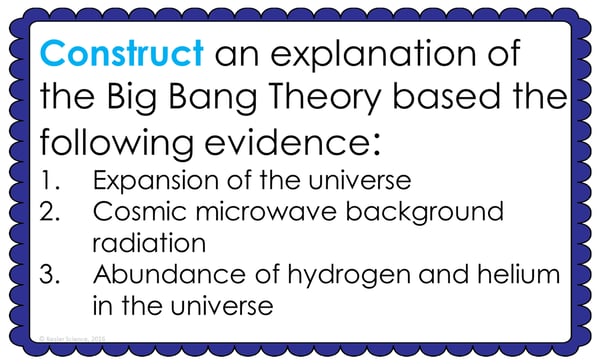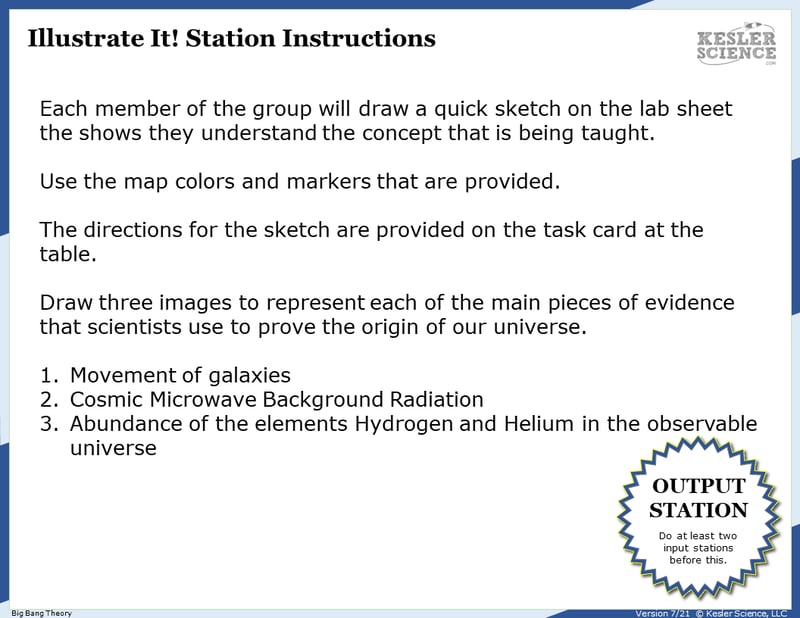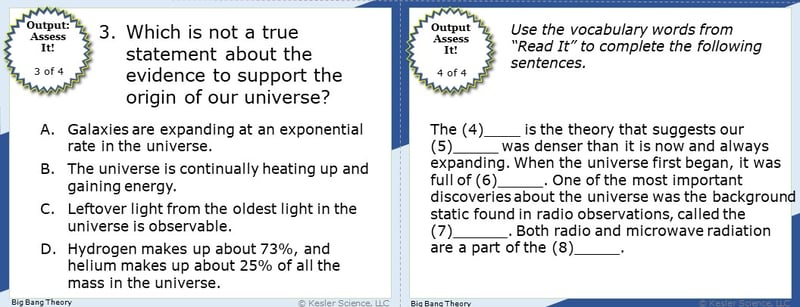Big Bang Theory Lesson Plan – A Complete Science Lesson Using the 5E Method of Instruction.
By the end of this comprehensive lesson about the big bang theory, students will be able to construct an explanation of how the big bang theory was initially hypothesized based on the following evidence: the universe's expansion, cosmic microwave background radiation, and the abundance of hydrogen and helium in the universe. Each of our lessons is designed using the 5E method of instruction to ensure maximum comprehension by the students. This well-thought out unit does the heavy lifting, giving teachers easy-to-implement, highly engaging lesson plans.
This blog will walk you through each of the steps and activities from the Big Bang Theory 5E Lesson Plan.
ENGAGEMENT
At the beginning of the lesson, the class will watch a short clip from the hit TV show The Big Bang Theory as Sheldon tries to explain the birth of the universe to Penny. Afterwards, teachers and students will discuss the objectives and some of the relevant vocabulary using the included objective statements and word wall cards.

The engagement activity will continue with a Think-Pair-Share activity to discuss what the students saw in the clip and how they will be learning about the evidence that helps support this theory. The teacher will then help to clear any misconceptions their students have about the creation of the universe through evidence. Teachers should remain aware and ready for the fact that some students will want to discuss their religious beliefs to explain the origin of the universe.
Estimated Class Time for the Engagement: 20-30 minutes
EXPLORATION
This student-centered station lab is set up so students can begin to explore the big bang theory. With nine stations in total, you can introduce the big bang theory to your middle school students in a variety of ways! Four of these stations are considered input stations where students will learn new information about the birth of the universe, and four of the stations are output stations where students will be demonstrating their mastery of the lesson's material. A bonus station offers challenges for your early finishers and independent learners. You can read more about how I set up the station labs here.
Watch It!
At this station, students will watch a six minute long video describing the big bang theory. The video will give a very detailed explanation as to what the theory itself and the evidence to support this theory. Students will then answer some questions relating to the video and record their answers on their lab station sheet.
Read It!
This station will provide students with a one-page reading about Cosmic Microwave Background (CMB), a piece of evidence that supports the Big Bang Theory. Students are asked four questions about the reading, including descriptions of CMB, light years, and fill in the blanks.
Explore It!
Students will be working in pairs to create a model of the universe by blowing up a balloon. Students will place a number of dots on the balloon and measure their distances as the balloon expands. Students will get a chance to see just how we know how the universe is expanding.
Research It!
The research station will allow students to get online and interact with an infographic to answer a number of questions and infer what might happen in the future. Students will also be making connections with topics like gravity, elements, and parts of atoms.
Organize It!
The Organize It station allows your students to use a manipulative to match information provided to either the movement of galaxies, cosmic microwave background, and similar elements found in the universe.
Illustrate It!
Your visual students will love this station. Students will be illustrating the three pieces of evidence that support the Big Bang Theory; movement of galaxies, CMB, and abundance of elements in the universe.

Write It!
Students who can answer open-ended questions about the lab truly understand the concepts that are being taught. At this station, the students will be answering three questions like describe how the galaxies are moving across the universe, chemical compositions of the universe, and how to read a CMB.
Assess It!
The Assess It station is where students will go to prove mastery over the concepts they learned in the lab. The questions are setup in a standardized format with multiple choice answers. Some questions will ask students to identify the correct pieces of evidence that support the Big Bang, abundant elements in the universe, etc…

Challenge It! - Bonus Station
Early finishers and advanced students will love the extension activities in this station. Four activity choices offer them ways to expand their learning through mini-games and mini-projects.
Estimated Class Time for the Exploration: One or two 45-minute class periods
EXPLANATION
The explanation activities will become much more engaging for the class once they have completed the exploration station lab. During the explanation piece of the lesson, the teacher will be clearing up any misconceptions their students may have about the big bang theory with a variety of materials. These materials include on-level and modified versions of the interactive presentation (may be used individually or projected), anchor charts, and paper or digital interactive notebook activities. If you have students that need modified notes, the 5E lessons come equipped to help give every student access to the lesson.
Interactive notebook samples: Above-left is a digital INB activity slide; above-right is an example of the paper INB activities.
The students will also be interacting with their journals using INB templates for the big bang theory. Each INB activity is designed to help students compartmentalize information for a greater understanding of the concept. The big bang theory INB template will challenge the students to understand and visualize the expansion of the universe.
Estimated Class Time for the Exploration: Two or three 45-minute class periods
ELABORATION
The elaboration section of the 5E method of instruction gives students choices that allow them to prove they’ve mastered the concepts behind the lesson. When students are given a choice, they’re much more enthusiastic and invested in the project than they are when their teachers choose their projects for them. There are a total of nine choices to demonstrate understanding of the Big Bang theory. A separate set of choices that offer more teacher support are also available for students that need them. Rubrics guide students to doing their best work and assist in grading

Estimated Class Time for the Elaboration: Two or three 45-minute class periods (can also be used as an at-home project)
EVALUATION
The final piece of the 5E model is an evaluation of your students' comprehension. Included in every 5E lesson is a homework assignment, assessment, and modified assessment. Research has shown that homework needs to be meaningful and applicable to real-world activities in order to be effective. When possible, I like to give open-ended assessments to truly gauge the student’s comprehension.
Estimated Class Time for the Elaboration: One 45-minute class period
DOWNLOAD THE FULL LESSON NOW
Download Over $100 in FREE Resources
For Middle School Science
Simply create a login below and gain immediate access to a selection of our Kesler Science product line worth $100 - for FREE. There's a full version of every product type! You'll also join tens of thousands of middle school science teachers who receive timely tips and strategies straight to their inbox.







